10/03/2021
Just ten more days until the official start of Fall and there are so many projects to wrap up before winter. Frequent, if not heavy rainfall, kept the porch deck wet. So all of the hours spent cleaning, deoxidizing and other prep work for staining and sealing 1,000 square feet of cedar boards will have to be done again in the spring.
Tall, birch and maple saplings closely line the driveway and need to be cut back. If not, the weight of snow and ice from winter storms will cause them to bow over to the blacktop and freeze in the ice, blocking traffic and the snow blower.
Fall insect spray, replace the floodlight on the shop, fall lawn prep, trim paint touch up, fruit tree pruning. Seems projects get worked every day, but the list keeps growing and I keep slowing. Ah yes, the pride of home ownership. Right about the time my wife and I convince ourselves it is worth all of the work, just for the privacy and view, the leaves will turn brown and blanket the lawn and the tax bill will arrive in the mail. But then there is always fall deer season…
This year, I believe I will set aside bolt and lever actions and go with Ruger Mini Thirty. Why not? They are fun to shoot, enough gun for the largest Maine deer and little to carry through dense Maine tree growth and brush.
Expectations for accuracy
 The current state of bolt action rifles, synthetic stocks and V block bedding of one type or another, have created a generation of shooters with an expectation of sub MOA accuracy long guns. That is not to say expectations are always met, or that the shooter can deliver, or that this level of accuracy is even useful.
The current state of bolt action rifles, synthetic stocks and V block bedding of one type or another, have created a generation of shooters with an expectation of sub MOA accuracy long guns. That is not to say expectations are always met, or that the shooter can deliver, or that this level of accuracy is even useful.
Read through a few threads on gun boards and you’ll find that about everyone shoots the erasers off of pencils at 300 yards and express disappointment to the core if the pencil’s ferrule is disturbed. No, I doubt they are aware that the accuracy they routinely profess exceeds worldwide bench rest records.
My very, very… very old Model 336 Marlin 30-30 WCF shot when new, and still shoots, 4″ 5 shot groups. It has been used routinely to hunt deer and hogs inside 100 yards. As a young hunter… in the days before hunters climbed tree stands, fell and dangled from harnessed like downed WW II paratroopers, preseason rifle checkout was simple; using metallic sights, shoot holes into an NRA SR-1 target placed out at 100 yards. A couple of 5 shot groups in the 6 3/2″ black and the rifle was good to go.
The thing about hunting with an old rifle and favorite ammunition is that you will eventually be able to anticipate where the second shot will hit, relative to the first, and the third relative to the second, etc. Group size does not have to be tiny as long as shots fall predictably and the shooter is familiar with his rifle.
Not an MOA to be found, not even in war…
While the military has always had refined versions of service rifles for use by snipers and for use in marksmanship competition, issue rifles from the 1903 Springfield through to the M1 Garand and M14 have a 5.0″ – 5.5″ 100 yard group standard.
This did not improve much with newer issue rifles. The M16 and M4 have a 4″ group standard. The Ruger Mini Thirty is, for all intent and purposes, a downsized M14, but significantly more accurate.
Which Mini Thirty are they talking about?
Introduced to consumers in 1987, the Ruger Mini Thirty and Mini 14 have evolved over the years. In 2003, the Ruger Mini production process was overhauled and tolerances tightened. The gas system was modified to reduce barrel vibration and metallic sights were upgraded. The result was a significant improvement in accuracy.
2007 brought a thicker barrel taper at the gas block and improved production process again tightened parts fit. Further headway was made in improved accuracy.
While people who never or rarely shot the Mini 14 and Mini Thirty, or are prone to exaggeration, and critically report shotgun like groups in the comments sections of social media, the numerous examples I have worked with over the past four or five years will put up between 1 3/4″ and 2 3/4″ 5 shot groups, with performance very much dependent upon factory ammo selected, time of day, ambient temperature, and winds aloft.
Careful modification to bedding, trigger, gas system, and barrel tensioning can consistently yield a Mini that can deliver sub 1″ groups.
Personally, I am OK with 2 3/4″ groups and a lot less time, effort and extracurricular to firearm purchase funding. See previously mentioned old Marlin.
The stubby 7.62×39 for the stubby Ruger Mini Thirty
|
Mini Thirty |
|
|
Manufacturer |
Ruger – USA |
| Model # | 5804 |
| Barreled Action |
Stainless Steel |
| Stock | Hardwood |
| Action Type | Fixed Piston / Moving Cylinder – Gas |
| Caliber | 7.62 x 39 |
| Magazine Capacity | 2 x 5 Rounds As Supplied |
| Barrel Length | 18.50″ |
| Twist Rate | 1:10″ |
| Sights | Adjustable Peep Aft – Blade Front |
| Scope Mounting | Ruger Rings & Rail Included |
| Overall Length | 37.50″ |
| Length of Pull | 13.0″ |
| Weight | 7 lbs |
| Trigger Pull | 5 lbs 11 oz |
| MSRP | $1279 |
The current Mini Thirty 7.62×39 is supplied with 2 5 round magazines, proprietary Ruger rings that clamp to scalloped cut into the sides of the rifle’s the receiver and lock into keyways in the top of the receiver.A Picatinny standard rail is included for folks who opt non-Ruger system scope mounting or red dot and similar sight systems. Both 10 and 20 round magazines are available as after sale accessories at ShopRuger.Com.
Above, a little more detail image illustrating scope/sight mounting systems.
Controls are in easy reach and about where your hands would expect to find them. The bolt locks open on empty to facilitate reloading.
The 7.62×39 imported and domestic versions
The 7.62x39mm was adopted by the Russian military in 1943, predominately finding its way into the Russian semi automatic SKS, selective fire AK47 rifles and the RPD light machine gun. Eventually, inexpensive semi automatic versions of military surplus firearms were imported into the United States along with huge quantities of inexpensive military surplus ammunition.
The cartridge and rifles became very popular. So much so that Ruger introduced the Mini Thirty, chambered in 7.62×39 in 1987 for both domestic and export markets. Ruger reinforced their commitment to the cartridge in 1991 when that chamber was also made available in the Ruger M77 Mark II. Ruger currently offers six variations of Mini Thirty and one bolt action American Ranch rifle in 7.62×39.
There are at least two consumer versions of the 7.62×39. The Russian submitted version of the 7.62×39 exists as a CIP cartridge with a 7.92mm (0.311″) diameter projectile and 3550 BAR (51,476 PSI) Pmax pressure rating. The 7.62×39 SAAMI version has a 0.311″ +0.000″/-0.002″ bullet diameter spec and 45,000 PSI MAP. The Ruger Mini-Thirty’s nominal groove diameter is 0.3105″ and bore diameter is 0.3080″, The Mini Thirty is designed for use with SAAMI complaint ammunition.
Topping off an 812 Superfast gas tank with kerosene
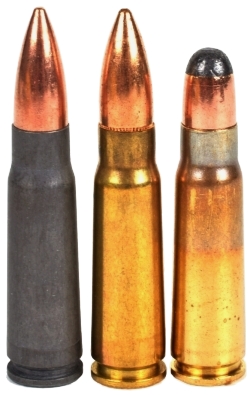 OK, an 812 Superfast may be overselling the point, but maybe… a Ford F-150 4×4 with a 5.0 L cammer. For some reason, some folks insist on shooting really terrible ammunition with their Ruger Min Thirty firearms.
OK, an 812 Superfast may be overselling the point, but maybe… a Ford F-150 4×4 with a 5.0 L cammer. For some reason, some folks insist on shooting really terrible ammunition with their Ruger Min Thirty firearms.
One of the quickest ways to get improved accuracy from a Mini Thirty is to use proper ammunition… which is defined in at least three sections of the owner’s manual as U.S. or foreign SAAMI complaint production. Proper ammunition, not expensive ammunition.
Brass casings, boxer primers, a bullet diameter of 0.311 +0.000″/-0.002″ and 45kpsi MAP. Not the same a CIP standard 3550 BAR (51,476 psi) Pmax ammunition are not the same as steel cased, Berdan primed, poly coated Russian and similar bulk ammo. Not only does the use of non-spec ammo result in inaccuracy, but hard Berdan primers result in misfires.
L – R: Herter’s steel cased, Berdan primed 122 grain (2 3/4″ groups), Federal American Eagle, brass case, Boxer primed 124 grain (2 1/2″ groups), PPU brass case, Boxer primed, 123 grain (5/8″). I attribute the accuracy of the PPU ammo to its 100+ fps high velocity and short bullet as better stabilized with the rifle’s 1:10″ twist.
Handloading and right size bullets
I have, and do, occasionally reload 7.62×39 ammo with 0.308″ diameter bullets. When I do, the best accuracy comes from short, flat base, round nose bullets produced for the 30-30 WCF cartridge. They seem to stabilize the best and ballistic coefficient within a hundred yards can be barn door like without adverse effect. As the 7.62×39 delivers 30-30 WCF like performance, these bullets penetrate and expand well on medium size game.
Still, I have had good luck cherry picking 0.310″ – 0.311″ bullets, some intended for the 7.62×39, some for the 303 British, some for others. Most reloading manuals list both 0.308″, 0.310″ and 0.311″ bullets within the load data they provide for the 7.62×39. Most reloading die sets come with an expander ball in 0.308″ and 0.311″.
Most manufacturers, firearms and reloading component recommend cannelured bullets and crimping. I do follow that recommendation and use a Lee Factory Crimp die when no cannelure is present. I do not crimp ammunition when assembled for a bolt action application and I tend to work at higher chamber and bore pressure levels.
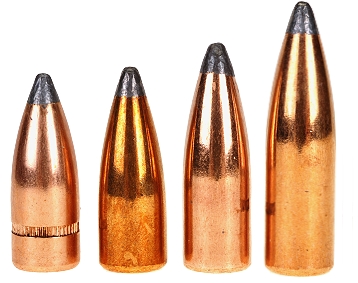
| Bullet | Grains | Type | Diameter “ | Length “ |
| Hornady Interlock | 123 | JSP | 0.310 | 0.875 |
| Sierra Pro Hunter | 125 | JSP | 0.311 | 0.905 |
| Speer Hot-Cor | 150 | JSP | 0.311 | 1.006 |
| Sierra Pro-Hunter | 180 | JSP | 0.311 | 1.192 |
Other than the Hornady 123 grain, which is made specifically for the 7.62×39, all bullets are box labeled for the 303 British. However, all bullet diameters fall within the SAAMI 7.62×39 spec. All are bullets we have used routinely and effectively with the 7.62×39 and are the basis for our published load data.
This time around…
Warning: Bullet selections are specific, and loads are not valid with substitutions of different bullets of the same weight. Variations in bullet length will alter net case capacity, pressure and velocity. Primer selection is specific and primer types are not interchangeable. These are maximum loads in my firearms and may be excessive in others. All loads should be reduced by 5% as a starting point for development where cartridges have greater than 40 grains in capacity and 10% for cartridges with less than 40 grain capacity following safe handloading practices as represented in established mainstream reloading manuals. Presentation of these loads does not constitute a solicitation for their use, nor a recommendation.

| 7.62×39 – MAP 45KPSI |
|
| Firearm | Ruger Mini-Thirty |
| Barrel Length | 18.50″ |
| Max Case Length | 1.528″ +0.000″/-0.015″ |
| Min – Max COL | 2.150″ – 2.200″ |
| Primer | CCI 200(LR) |
| Bullet Diameter | 0.3110″ +0.000″/-0.0020″ |
| Reloading Dies | Lee Precision |
| Bullet Type | Bullet Weight Grains |
Net H2O Grains Capacity |
COL” | Powder Type | Powder Charge Grains |
Muzzle Velocity fps |
Muzzle Energy ft/lbs |
3 Shot 100 Yard Group” |
| Hornady Interlock | 123 |
31.5 |
2.190 |
AA 1680 |
27.0 |
2411 |
1587 |
1.8 |
| Hornady Interlock |
123 | 31.5 | 2.190 | Re 10x | 29.0C | 2462 | 1656 | 1.6 |
| Hornady Interlock |
123 | 31.5 | 2.190 | CFE BLK | 29.5 | 2554 | 1782 | 2.2 |
| Hornady Interlock |
123 | 31.5 | 2.190 | H335 | 32.0 | 2391 | 1562 | 1.5 |
| Sierra Pro-Hunter |
125 |
29.8 |
2.150 |
Re 7 |
27.0 |
2408 |
1610 |
1.4 |
| Sierra Pro-Hunter |
125 | 29.8 | 2.150 | Re 10x | 28.0C | 2417 | 1622 | 2.0 |
| Sierra Pro-Hunter |
125 | 29.8 | 2.150 | CFE BLK | 29.0 | 2379 | 1571 | 1.2 |
| Sierra Pro-Hunter |
125 | 29.8 | 2.150 | H335 | 31.5 | 2415 | 1619 | 1.9 |
| Speer Hot-Cor |
150 |
28.7 |
2.190 |
AA 2015 |
27.0 |
2177 |
1579 |
1.7 |
| Speer Hot-Cor |
150 | 28.7 | 2.190 | Re 10x | 26.0 | 2156 | 1549 | 1.5 |
| Speer Hot-Cor |
150 | 28.7 | 2.190 | AR-Comp | 28.0C | 2170 | 1569 | 2.1 |
| Speer Hot-Cor |
150 | 28.7 | 2.190 | H335 | 29.0 | 2165 | 1562 | 1.8 |
| Sierra Pro-Hunter |
180 |
25.6 |
2.200 |
AA 2015 |
23.5 |
1810 |
1310 |
2.5 |
| Sierra Pro-Hunter |
180 | 25.6 | 2.200 | Re 10x | 22.5 | 1883 | 1418 | 2.3 |
| Sierra Pro-Hunter |
180 | 25.6 | 2.200 | AR-Comp | 24.5C | 1792 | 1284 |
2.1 |
| Sierra Pro-Hunter |
180 | 25.6 | 2.200 | H335 | 25.5 | 1845 | 1361 | 2.2 |
And this works for me…
I always try to post a more complete picture for engineers who have taken up shooting sports and tell me I do not provide enough information. The reloading press was bright green, the little trays that hold components were dark blue and I was listening to easy listening rock while reloading. Resizing effort was 23 fig newtons. For everyone else, the 7.62×39 is easy to reload and requires only following the conventions at the front of every reloading manual that has been printed for the past one hundred years.
Yes, I am getting cranky. It is just about supper time. I had a lot of fun working with the Ruger and now I feel like taking a nap, but I have to write this all down…
For people who hunt dense woodland, and perhaps those with a need for a rural home defense gun, the Ruger Mini Thirty is a good fit. For folks who like to go to the range, shoot a gun with character and hang out with friends, the Ruger Mini Thirty is again a good answer. For deer, hogs, coyote size varmints, and a gun that can be carried on a sling with a hand left free for selfies, the Mini Thirty would be a good one.
If the objective is to shoot from a bench every day, blow through 500 rounds of ammo and put them all through a single hole in a target, this would not be the gun.
Yes, there is a good deal more in the Ruger Mini Thirty to unlock, and there are specialty shops that will guarantee sub 1″ performance for a not ridiculous price. But for out of the box performance and for brush hunting in Maine… and just about every place else with similar circumstances, the performance is excellent.
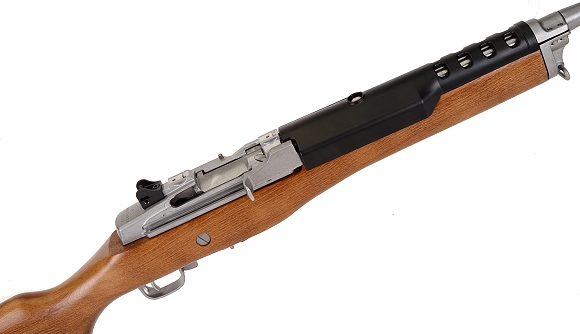

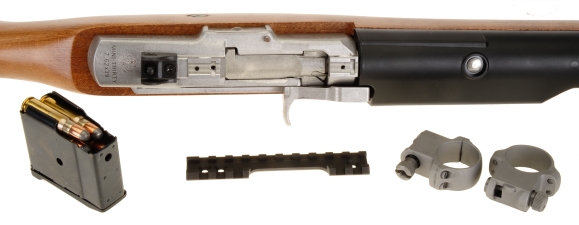
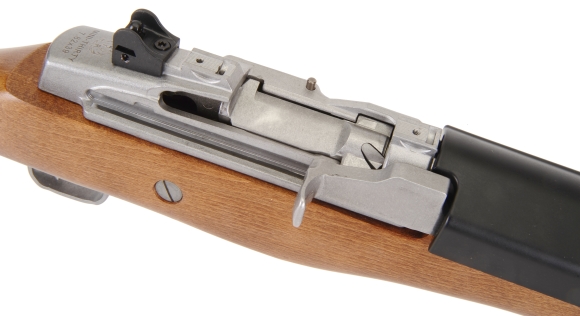
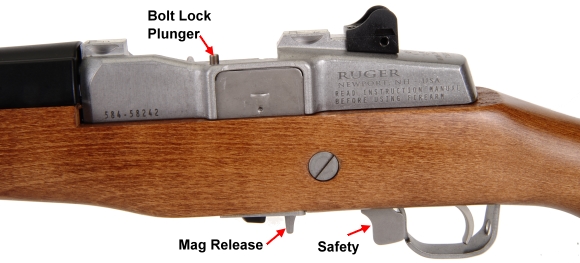

Email Notification